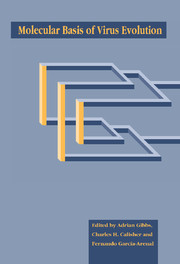Book contents
- Frontmatter
- Contents
- List of contributors
- Editors' preface
- Conference participants
- 1 Introduction and guide
- Part I The impact of viral diseases
- Part II Origins of viruses and their genes
- Part III Sources of virus variation
- Part IV Molecular interactions of viruses and their hosts
- Part V Viruses, hosts and populations
- 13 Quasi-species: the concept and the word
- 14 The co-evolutionary dynamics of viruses and their hosts
- 15 Population genetics of viruses: an introduction
- 16 Origin and evolution of prokaryotes
- 17 Molecular systematics and seed plant phylogeny: a summary of a parsimony analysis of rbcL sequence data
- Part VI Case studies of viral taxa; their systematics and evolution
- Part VII Techniques for viral systematics
- Index
17 - Molecular systematics and seed plant phylogeny: a summary of a parsimony analysis of rbcL sequence data
Published online by Cambridge University Press: 04 May 2010
- Frontmatter
- Contents
- List of contributors
- Editors' preface
- Conference participants
- 1 Introduction and guide
- Part I The impact of viral diseases
- Part II Origins of viruses and their genes
- Part III Sources of virus variation
- Part IV Molecular interactions of viruses and their hosts
- Part V Viruses, hosts and populations
- 13 Quasi-species: the concept and the word
- 14 The co-evolutionary dynamics of viruses and their hosts
- 15 Population genetics of viruses: an introduction
- 16 Origin and evolution of prokaryotes
- 17 Molecular systematics and seed plant phylogeny: a summary of a parsimony analysis of rbcL sequence data
- Part VI Case studies of viral taxa; their systematics and evolution
- Part VII Techniques for viral systematics
- Index
Summary
Introduction
Plant systematics has experienced a methodological revolution in the last three decades. Parsimony analysis of character-state transformations and recognition of strictly monophyletic groups have given systematists the ability to explore the evolutionary relationships of plants with more rigour than in the past. Additionally, recent technological advances and developments in molecular biology have provided systematists with valuable new sources of data for phylogeny reconstruction. ‘Molecular systematics’ is a rapidly expanding field that includes the use of restriction endonuclease sites and nucleotide sequences, among other sources of information (Hillis & Moritz, 1990). Within the embryophytes and in some algal groups (e.g. Rhodophyta, Chlorophyta) chloroplast DNA is the molecule of choice for most plant systematists (Palmer et al., 1988). The chloroplast genome is small, highly conserved, present in a large number of copies and usually inherited only from the female parent. All green plants possess a chloroplast genome that is structurally conserved across most major groups. Thus the chloroplast genome provides a source of data potentially comparable at high taxonomic levels.
Other sources of molecular data are the mitochondrial genome (mtDNA; Palmer, 1992) and ribosomal RNA and DNA (rRNA and rDNA; Hamby & Zimmer, 1992). The mitochondrial genome in plants is large, and its nucleotide sequence evolves slowly. However, it is subject to frequent structural rearrangements and insertions and deletions. These attributes render plant mtDNA of little systematic use in studies involving either restriction sites, which are dependent on a relatively stable genome, or sequences (Palmer, 1992).
The genes for rDNA code for ribosomal rRNAs, and are very conserved owing to structural features.
- Type
- Chapter
- Information
- Molecular Basis of Virus Evolution , pp. 243 - 252Publisher: Cambridge University PressPrint publication year: 1995



